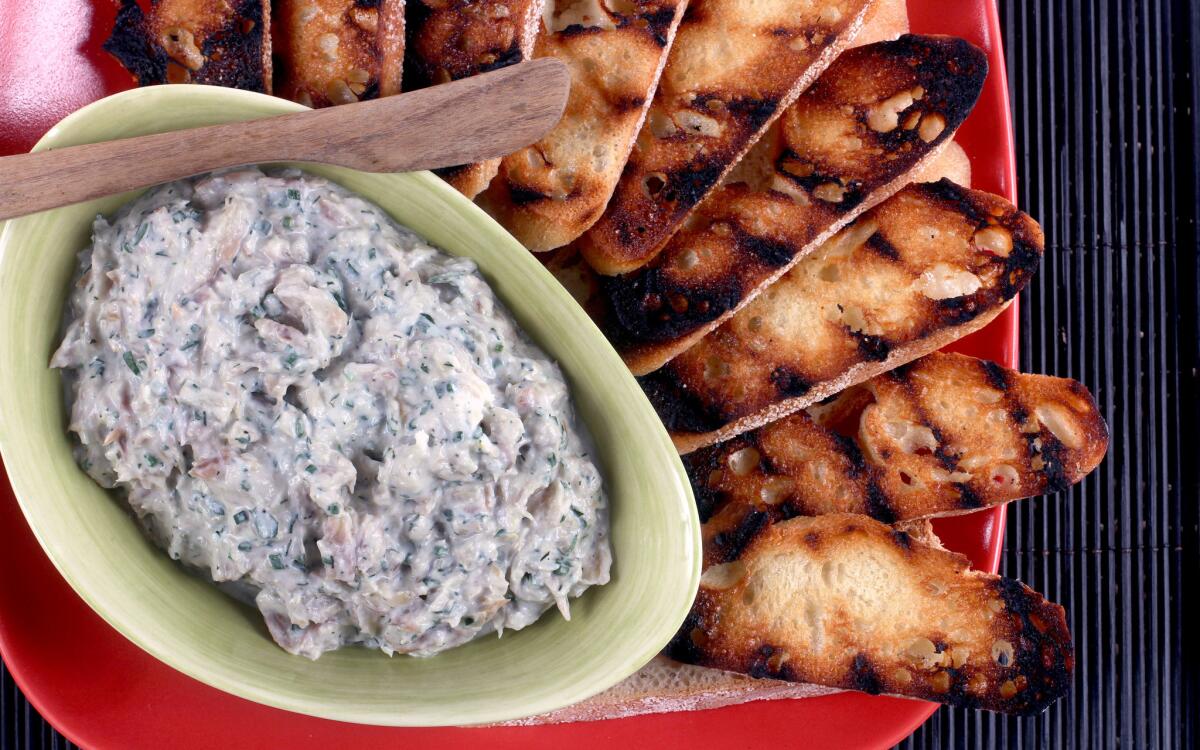Smoked trout rillettes

It’s dawn, and you’re camped at a small creek in the Sierra Nevada foothills, just south of Mammoth, a few hours from the chaos of Los Angeles. Maybe you’re at Rock Creek, maybe McGee Creek. The quaking aspens and pine trees have replaced the city traffic. You grab your lucky wooden creel and stow a cold beer along with your bait and a few extra hooks. The creek bed is steep in places, tight with trees and tall grasses, and you carefully wind your way down toward the water. The cold creek laps against the river rocks and fallen logs. Settling in near a dark hole, you’ve found your first spot, careful to cast no shadow along the water so the fish don’t know you’re there.
Trout fishing is as much about the ritual as it is about getting fish. However you fish — whether by fly or bait — it’s about capturing the right moment, knowing your target and enjoying the game. On a good morning, you can catch your limit in trout: five a day in California, and you can have 10 in your possession at any given time, depending on where you fish (check local regulations and, yes, you need a license). You’re not looking for the stocked trout, which you’ll find in some locations. They’re typically small and will snap at anything. You want the older fish, the ones living in the dark pockets of the river or the natural dams formed from the fallen trees. These are the ones that know the game, won’t fall for any bait — and taste the best.
After you land one — fighting with the line, slowly tiring the trout as you reel it in — you want to honor it. Cook it right, so that your meal will be as enjoyable as your afternoon on the water.
As trout season ends quickly — typically in November — and there are times when you won’t be able to hook the right fish, there’s no shame in buying your trout instead of catching it. And there are many, many fans of trout meunière who wouldn’t know a fishing rod from a pool cue. In that case, stop by a good fish market before your dinner. If you buy, look for fish that smells like the river — not fish that smells “fishy” — with clear eyes and firm, clean flesh.
You don’t have to do much to make a great meal out of trout, at the campsite, over the proper grill or even at home in your kitchen. Chef Michael Cimarusti, who loved fishing as a kid so much he opened a pair of seafood restaurants, has a three-step recipe for frying trout. Just coat the cleaned fish with seasoned flour, then pan-fry them in a little bacon grease and browned butter. A squeeze of lemon and you’re done.
If you want to dress your trout up a bit, add cornmeal to the flour mixture. Or stuff the fish with thinly sliced lemon, capers and parsley, and grill them over the fire. The aroma will tell you when the fish is ready.
If you’re a fan of fishing, odds are you’ll have more than enough trout to take home. Store the fish in an ice chest lined with dry ice; the frozen fish will keep until you get them home. With the fish you’ve kept, brine them with a little garlic, shallot, lemon and bay leaf, then hot-smoke them over alder wood. The trout will be ready in about an hour, their skins caramelized and perfumed by the wood.
Serve or share the smoked trout as-is, or flake it and make rillettes. Smoked trout makes a perfect dip, great for serving to friends as you regale them with your big fish stories. And if you never made it out of town? That fish story just got bigger.
In a large bowl, whisk together the crème fraîche, yogurt, horseradish, lemon zest and juice, dill, chives, parsley and pepper. Fold in the flaked trout. This makes almost 4 cups rillettes, which will keep, covered and refrigerated, up to 5 days.
Get our Cooking newsletter.
Your roundup of inspiring recipes and kitchen tricks.
You may occasionally receive promotional content from the Los Angeles Times.
















